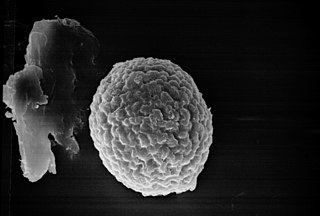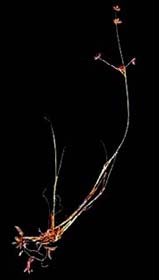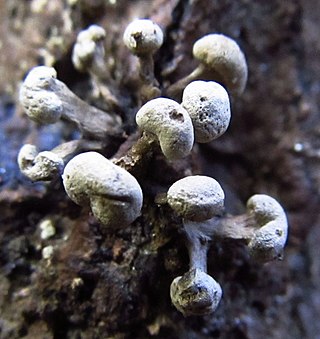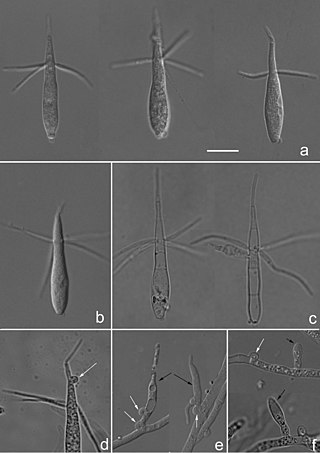
Helicobasidium purpureum is a species of fungus in the subdivision Pucciniomycotina. Basidiocarps are corticioid (patch-forming) and are typically violet to purple. Microscopically they have auricularioid basidia. Helicobasidium purpureum is an opportunistic plant pathogen and is one of the causes of violet root rot of crops and other plants. DNA sequencing suggests that it is a complex of more than one species. The species has a conidia-bearing anamorph in the Tuberculina persicina complex that is a parasite of rust fungi.
Helicobasidium longisporum is a species of fungus in the subdivision Pucciniomycotina. Basidiocarps are corticioid (patch-forming) and are typically violet to purple. Microscopically they have auricularioid basidia. Helicobasidium longisporum is an opportunistic plant pathogen and is one of the causes of violet root rot of crops and other plants. DNA sequencing suggests that it is a complex of more than one species.
Helicobasidium mompa is a species of fungus in the subdivision Pucciniomycotina. Basidiocarps are corticioid (patch-forming) and are typically violet to purple. Microscopically they have auricularioid basidia. Helicobasidium mompa is an opportunistic plant pathogen and is one of the causes of violet root rot of crops and other plants. DNA sequencing suggests that it is a distinct, eastern Asian species.

Pucciniomycotina is a subdivision of fungus within the division Basidiomycota. The subdivision contains 10 classes, 21 orders, and 38 families. Over 8400 species of Pucciniomycotina have been described - more than 8% of all described fungi. The subdivision is considered a sister group to Ustilaginomycotina and Agaricomycotina, which may share the basal lineage of Basidiomycota, although this is uncertain due to low support for placement between the three groups. The group was known as Urediniomycetes until 2006, when it was elevated from a class to a subdivision and named after the largest order in the group, Pucciniales.

The Entylomatales are an order of smut fungi in the class Exobasidiomycetes. A monotypic order, it consists of a single family, the Entylomataceae. Both the family and order were circumscribed in 1997.

The Tilletiales are an order of smut fungi in the class Exobasidiomycetes. It is a monotypic order, consisting of a single family, the Tilletiaceae, which contains seven genera. The roughly 150 species in the Tilletiales all infect hosts of the grass family, except for species of Erratomyces, which occur on legumes.

Entorrhizomycetes is the sole class in the phylum Entorrhizomycota within the Fungi subkingdom Dikarya along with Basidiomycota and Ascomycota. It contains three genera and is a small group of teliosporic root parasites that form galls on plants in the Juncaceae (rush) and Cyperaceae (sedge) families. Prior to 2015 this phylum was placed under the subdivision Ustilaginomycotina. A 2015 study did a "comprehensive five-gene analyses" of Entorrhiza and concluded that the former class Entorrhizomycetes is possibly either a close sister group to the rest of Dikarya or Basidiomycota.

The Atractiellomycetes are class of fungi in the Pucciniomycotina subdivision of the Basidiomycota. The class consists of a single order, the Atractiellales, which contains 3 families, 10 genera, and 58 species.

The Classiculomycetes are a class of fungi in the Pucciniomycotina subdivision of the Basidiomycota. The class contains a single order, the Classiculales, which in turn contains the single family Classiculaceae. The family contains two monotypic genera.
The Cryptomycocolacomycetes are a class of fungi in the Pucciniomycotina subdivision of the Basidiomycota. The class contains a single order, the Cryptomycocolacales, which in turn contains the single family Cryptomycocolacaceae. The family has two monotypic genera.

The Mixiomycetes are a class of fungi in the Pucciniomycotina subdivision of the Basidiomycota. The class contains a single order, the Mixiales, which in turn contains a single family, the Mixiaceae that circumscribes the monotypic genus Mixia. Only one species has been described to date, Mixia osmundae; this species was originally named Taphrina osmundae by Japanese mycologist Toji Nishida in 1911. It is characterized by having multinucleate hyphae, and by producing multiple spores on sporogenous cells.
Basidiopycnis is a fungal genus in the family Hoehnelomycetaceae. The genus is monotypic, containing the single species Basidiopycnis hyalina. The species forms minute pycnidial basidiocarps in bark beetle tunnels. Teleomorphs produce auricularioid basidia, whilst anamorphs produce asexual conidia. Basidiopycnis hyalina was described from Germany and is also known from Italy and Switzerland. Anamorphic fruit bodies collected in Canada were given the name Basidiopycnides albertensis, but are currently considered conspecific with the European species.
Volvocisporiaceae is a fungal family in the class Exobasidiomycetes. The family contains the single genus Volvocisporium, which in turn contains the single species Volvocisporium triumfetticola, found on the leaves of Triumfetta rhomboidea in India.

Helicobasidium is a genus of fungi in the subdivision Pucciniomycotina. Basidiocarps are corticioid (patch-forming) and are typically violet to purple. Microscopically they have auricularioid basidia. Asexual anamorphs, formerly referred to the genus Thanatophytum, produce sclerotia. Conidia-bearing anamorphs are parasitic on rust fungi and are currently still referred to the genus Tuberculina.

Tuberculina is a genus of fungi in the order Helicobasidiales. The genus is a synonym of Helicobasidium, but currently species have not yet been assigned to the latter genus. Tuberculina species are conidia-bearing parasites of rust fungi, forming felt-like, purple patches on their hosts.

Eocronartium muscicola is a species of fungus belonging to the order Platygloeales. It is currently the only species in the monotypic genus Eocronartium. In the UK its recommended English name is moss rust. The species forms clavarioid basidiocarps on mosses, on which it is parasitic.

The Platygloeales are an order of fungi in the class Pucciniomycetes. Species in the order have auricularioid basidia and are typically plant parasites on mosses, ferns, and angiosperms, though Platygloea species appear to be saprotrophic.
The Spiculogloeomycetes are a class of fungi in the subdivision Pucciniomycotina of the Basidiomycota. The class consists of a single order, the Spiculogloeales, together with an additional, unassigned genus, Meniscomyces. Many species are currently known only from their yeast states. Species in the genus Spiculogloea form hyphal states that produce auricularioid basidia and are parasitic on other fungi.
The Spiculogloeales are an order of fungi in the subdivision Pucciniomycotina of the Basidiomycota. The order is currently monotypic, consisting of a single family, the Spiculogloeaceae. Species in the genus Phyllozyma are currently known only from their yeast states. Species in the genus Spiculogloea form hyphal states that produce auricularioid basidia and are parasitic on other fungi.
Ptechetelium cyatheae is a species of fungus belonging to the order Platygloeales. It is currently the only species in the monotypic genus Ptechetelium. The species forms effused basidiocarps on ferns, on which it is parasitic.











